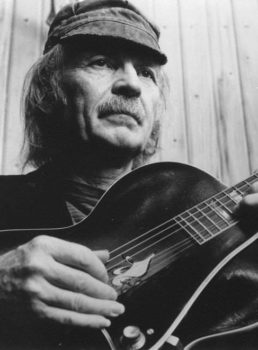
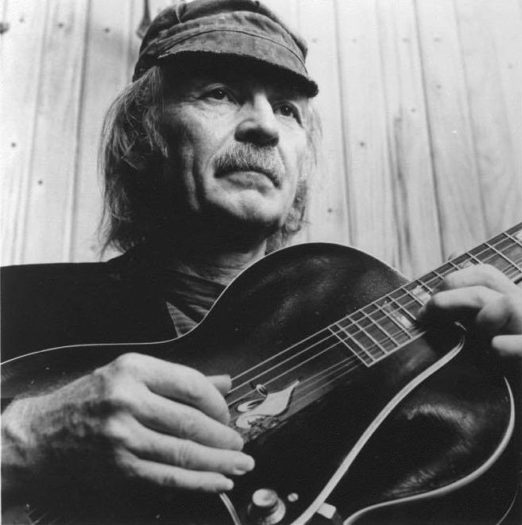
Michael Hurley is the sort of artist who inspires memorable descriptors. He’s been called “a vestige of the old, weird America” by the Boston Globe,” an “old-timey existentialist” by Robert Christgau, and “folk’s Boo Radley” by Pitchfork. My favorite, though, comes from roots-music magazine No Depression: “a crazy backwoods Vermont folkie, singing about werewolves and maids, drinking weasel piss, and enduring sausage farts.”
Hurley did not start out a “Vermont folkie” though. A lifelong traveler, he lived in California, Florida, New Orleans, Mexico, New York, Philadelphia, New Jersey, and Boston, before moving to Vermont in 1967 at age 25 – probably some other place I missed too. He remained a moving target even once he was in the state; he estimates he lived in 35 different towns in his two decades as a Vermonter (he dubs his strip of central Vermont “the insanity belt”). Hurley stayed in Vermont, but he certainly never settled.
The music he recorded and released in those 35 towns stands among his greatest, and his weirdest. There are songs about pork chops and hula hooping. There’s a song where he spents much of the time imitating a crow’s call. There are two different songs about monkeys, and one song about a werewolf that he recorded twice.
Hurley’s Vermont story is almost as strange and wondrous as Hurley’s Vermont songs, so we’re going to dive into each. Take a deep breath. It’s going to get weird.
Hurley first moved to Vermont in 1967 and lived there more on than off until 1987. A few years ago, he told the Vermont Historical Society that he arrived at the behest of jazz pianist John Cassel:
“He had sixty acres and a big band. He was very supportive of musicians coming up here. Friends I knew when I lived in Boston had played in his band. One day they were all getting in a car coming up here to a party at his house, and I came with him. When I met him, he walked me around his property. Eventually he let me live in his barn for a while.”
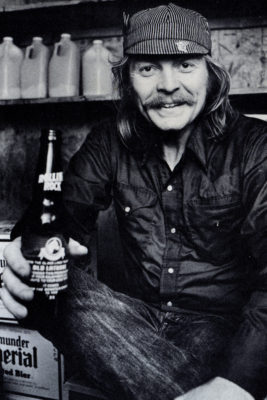 Hurley lived in quite a number of barns besides Cassel’s (and one time a teepee). He would contact the owners of vacated homes and ask if they wanted someone to watch the place. That way he could live for free while making sure nothing burned down – a task he didn’t always succeed at.
Hurley lived in quite a number of barns besides Cassel’s (and one time a teepee). He would contact the owners of vacated homes and ask if they wanted someone to watch the place. That way he could live for free while making sure nothing burned down – a task he didn’t always succeed at.
“I had three chimney fires here,” he told the Historical Society. “One was when I lived on top of Saint Albans hill. The chimney fire occurred when it was about 20 below. Didn’t have a telephone so I drove up to the nearest neighbor so I could use a phone [and] call the first department. But they weren’t there. So I went back and did what people say to do, open the woodstove door and let it blow itself out.”
This story would make a great song, but Hurley did not write a song about it. He has rarely written autobiographically, even when he biography is far more interesting than most of his folk-music peers’. Instead, his songs often combine Where the Wild Things Are animal fantasies with slice-of-rural-life asides.
For instance, Hi-Fi Snock Uptown, the first album he released while in Vermont (though recorded in California with The Youngbloods, of 1967 hit “Get Together” fame), included one his best-known songs – this is a relative term – “Eyes Eyes.” Some sample lyrics:
Protein monster ate a sack of poison sugar
Crawling out of the barn to the weeds to die
Rolling his eyes, eyes, eyes eyes
Mama Molasses broke my glasses
Then the moon came up and we wiggled our asses
She got red eyes, eyes
There’s a lot to unpack there, and I wouldn’t expend too much brain power trying to follow the plot. Hurley’s songs are the shaggiest of shaggy dog tales, so loose and nimble that they dodge any literal interpretation. But that’s not to say his lyrics are tossed-off – far from it. “Mama Molasses” sounds like the sort of alliterative character name Tom Waits might invent, a wacky throwaway that never comes up again. But Hurley’s characters go deep. Though the song only mentions her once, Hurley obsessives know that Mama Molasses is a six-breasted wolf who serves poisoned pie by the side of the road.
How would a listener possibly know that? Because Hurley is not just a songwriter; he is a visual artist. In addition to drawing the majority of his album covers by hand, he periodically writes comic books. Like Richard Scarry on acid, his cartoons are surreal and strange, childlike animals hiding a twisted underbelly. His cartoons mirror and expand upon his songs, and vic-versa.
Many of both feature protagonists Boone and Jocko. Two dogs based on pets he a neighbor had growing up, Boone and Jocko have recurred in his songs and visual art over the years – even once on the side of a cart Hurley sold hot dogs from.
“I started drawing them when I was in about 10th grade,” Hurley told Arthur Magazine. “We had these two collies. My brother and his friend used to sit around and make up stories about these dogs, based on their characters. We liked this guy Boone, this dog, he was kind of outrageous. He had a very different character from the other dog, whose name was Count. Count was blind in one eye. That’s why he’s got those dark glasses. But I changed his name to Jocko because there was this show on TV. It was an alternative to Dick Clark. It was the black version, called Jocko’s Rocket Ship. Jocko was the Interplanetary DJ. He had this show and it was really cool. So I changed Count’s name to Jocko. Then I blinded him in the other eye.”
One comic features Boone and Jocko encountering the aforementioned Mama Molasses:
In addition to the comics, Hurley has illustrated almost all of his album covers. His best illustration – or at least the illustration with the best story behind it – came on his next album, the collaborative Have Moicy!. It depicts a scene at a show he played up in Bethel, Vermont. He described it to Arthur Magazine:
“My brother’s girlfriend heaved a beer across the room at that gig. It hit a fiddle that was leaning against an amplifier and I did a drawing of that. It broke the fiddle. So it was Froggy’s idea—that painting of Thora chucking this beer. Froggy was looking at my drawings and says, ‘You don’t have it right. You gotta get the dimensions of the beer right. Bring that beer up, make it bigger. Make it so you can see that she threw it and so that you can see what it’s gonna hit.’ No one sees that the fiddle was doomed, but that was the story.”
This typically weird and surreal scene belies what is arguably his most accessible album. The key difference from most of his other work is that he is backed by an actual successful band, an offshoot of the 1960s Greenwich Village folkies the Holy Modal Rounders. Dubbed the Unholy Modal Rounders when co-founder Peter Stampfel broke away from his partner Steve Weber, the band provides a folk-rock muscularity that frames Hurley’s wilder impulses. It doesn’t constrict him, but it does make the weirdness of his contributions more palatable to a wider audience.
For instance, “Sweet Lucy” finds Hurley singing a catchy ditty that could have come straight out of Laurel Canyon:
In addition to the bulked-up backing band, Have Moicy! also features a new musical trick Hurley picked up in Vermont: fiddling.
“I had heard fiddlers before but I never wanted to play one until I heard them play fiddles in Vermont at the fiddle contests,” Hurley told Amoeba Records. “It was the geezers of Vermont & New Hampshire and Quebec who inspired me to fiddle. I was there when Jesse Winchester had a hit with his tune ‘Yankee Lady.’ And we had many chuckles over the open line, ‘I lived with the decent folks in the hills of old Vermont, where what you do depends on what you want.'”
Hurley’s greatest fiddling moment on record comes in the album’s “Slurf Song.” This ode to gluttony and the digestive tract features one of his most often-quoted lyrics (and only in Hurley’s world would this line be a crowd favorite): “Oh, a little wishbone – I make a wish for a potato.” It also features one of his relatively rare explicit references to Vermont on record: “Picking out the fishbones in my perch from Lake Champlain.”
As the Unholy Modal Rounders collaboration brought him a measure of popular acclaim, Hurley began playing with a second band that was quite the opposite. The Unholy Modal Rounders were seasoned professionals. Puddledock, on the other hand, were a local bar band Hurley stumbled upon in rural Vermont. He convinced them to change their name to Automatic Slim & the Fatboys and demanded that the band act out their new moniker.
“None of the Fatboys were actually fat,” he later recalled. “I had thought we might make a better stage presence if we all put pillows in our shirts while performing and I furnished the down pillows which we tried wearing for the first few gigs but we found that you soon get overly warm performing with a big old down pillow in your shirt. Eventually the pillows would be removed, and after a while all of them had been forgotten at the venues where we played.”
The Fatboys recorded one album in the 1970s, Fatboy Spring, though it didn’t see release until 2011. Where Have Moicy! was (comparatively) polished, Fatboy Spring was more typical Hurley, loose and shaggy. He memorialized in song a convoluted origin story for the Fatboys and its non-existent leader, Automatic Slim.
Hurley continued releasing albums from Vermont through the end of the 1970s and into the 1980s. In relatively quick succession came Long Journey (1977), Snockgrass (1980), and Blue Navigator (1984). All recorded with various local collaborators, the three featured new compositions mixed with reprises of previously-recorded songs (include yet another run at “Werewolf,” a song he’s released at least five times). Over the course of those albums though, Hurley’s relationship with the state soured. He moved away in 1987, twenty years after he first arrived.
“I finally got priced out of Vermont by the yuppies,” he told Arthur Magazine. “The last place I was living I paid 35 bucks a month. Usually I’d either have something like that or free. But it got to where you couldn’t find that so easily. So, I moved to Richmond [Virginia] ’cause you could have a lotta nice stuff for like 120 bucks a month – heat, a flush toilet, electric upstairs, downstairs.”
Even down in Virginia, he couldn’t shake Vermont entirely though, returning to several years later to record 1994’s Wolfways. He also released a live cassette in 1991, Growlin’ Bobo, combining two 1980 shows he’s given in Burlington’s neighboring city Winooski.
Hurley hasn’t lived in Vermont for thirty years. Currently based in Oregon, he continues to record, draw, and tour. Through it all, though, that No Depression quote we started with holds true up to the present day. Michael Hurley may no longer in the state, but he remains at heart “a crazy backwoods Vermont folkie, singing about werewolves and maids, drinking weasel piss, and enduring sausage farts.”
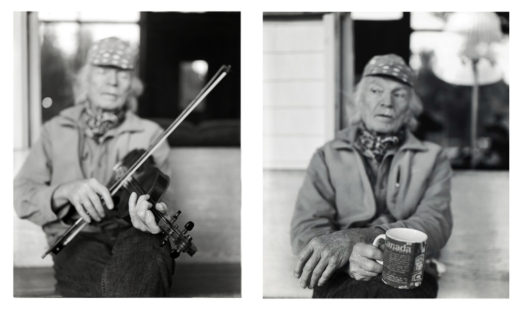
Click here to read more articles about Vermont music history.
2 Responses to “Michael Hurley’s Old, Weird Vermont”
Sorry, the comment form is closed at this time.

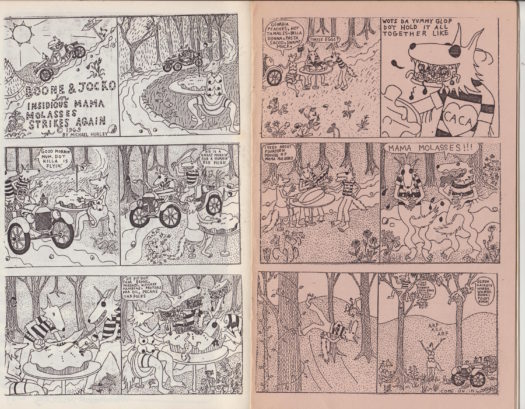
Wow! I’m so glad you found Michael Hurley and so surprised (and happy) he’s still alive considering his crazy lifestyle when I knew him! He was a fixture in Plainfield VT when I moved there in 1978. Many jam sessions, many parties, many late night ramblings I can remember with this guy present. I always thought he was brilliant. So happy he’s still making music.
I recorded LONG JOURNEY with Michael in 75-76? A fun time was had by all.